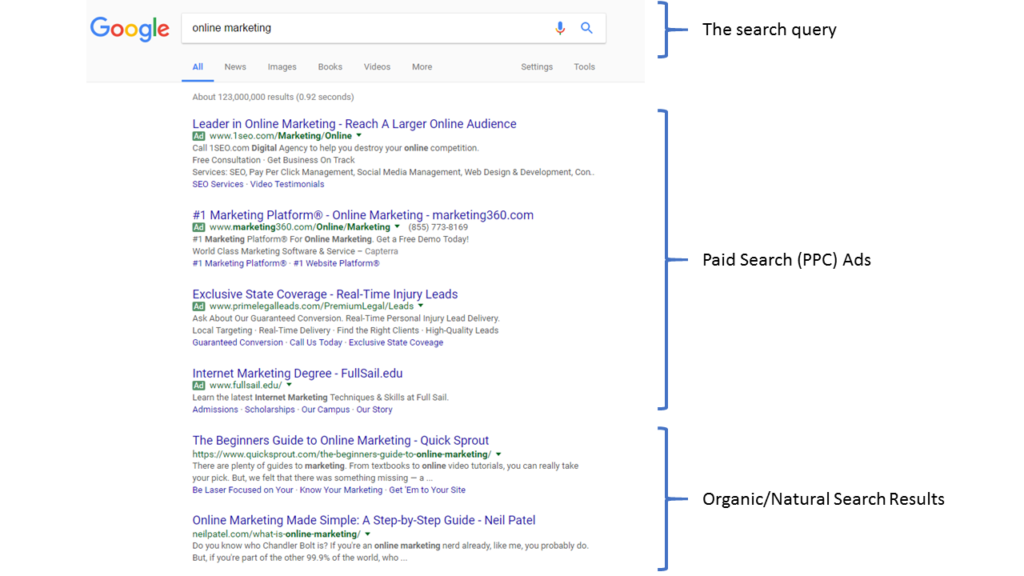Google AdWords can be intimidating for those new to the platform, but it’s an online marketing tool that small businesses and entrepreneurs should consider leveraging to drive quality traffic to their website. This brief guide will describe why AdWords is so powerful, introduce some vocabulary and describe the inner workings of the platform so you can dive into the pay-per-click world with confidence!
What is Google AdWords & Pay-per-Click (PPC) Marketing?
With over 2 trillion searches occurring on Google every year, it’s important for businesses to advertise to those searchers that are looking for their products or services. Pay-per-click (PPC) ads allow businesses to do exactly that. In response to relevant searches, advertisers can show an ad that appears above and below the organic/natural search results:

For business- and product-related searches, there are often local business results, shopping ads and other content that push the organic search results even further down the page, making it even more important to take an active approach in PPC, even if you’re actively optimizing your website with Search Engine Optimization (SEO).
Google AdWords is the platform that advertisers use to manage Paid Search ads on Google. Advertisers target keywords (words/phrases relevant to their business) and, in an auction setting, will compete for the right to show their ads to the user conducting a search. Because the user is actively searching for something (they have search intent), response rates to PPC ads are higher than many other forms of online marketing. I estimate, based on managing client programs, that 15-25% of searches result in clicks on PPC ads (for people searching for brands, this can be as high as 40-50%). The user’s search intent is the key to PPC success.
How Does the Google AdWords Auction Work?
The AdWords auction is not a simple bid-based auction like you might be accustomed to seeing. Since Google only makes money when a user clicks on an ad, it’s in their best interest to reward more relevant ads, since they’re more likely to be clicked. Here’s a simplified step-by-step description of the PPC auction:
- User submits their search query and the auction begins.
- Advertisers with keywords that match the search query are entered into the auction.
- AdWords conducts an Ad Rank auction, where bids & relevance are combined to generate an ad rank for each advertiser.
- The winning set of advertisers (typically 4-7 advertisers) show their ads to the user (each instance of an ad showing is called an impression).
- If the user clicks on an ad, they are sent to a page on the advertiser’s website, called a landing page. The advertiser is charged for the click.
- When the user completes a desired action (like purchasing something or completing a form on the website), a conversion is tracked in the platform. (This is technically after the auction process, but completes the thought.)
Why Relevance is Critical to Successful PPC
As described above, both the bid and relevance are part of the AdWords auction. While the bid is simply the amount an advertiser is willing to pay per click (we call this maximum CPC) and easily controlled by the advertiser, relevance takes a little more effort. When an advertiser is entered into an auction based on their keyword matching a search query, Google calculates a relevance score, called Quality Score. This score (from 1-10) analyzes relevance based on how well the keyword, ad and landing page for that advertiser match the user’s search query. Google also considers historical response rates (AdWords calls this the click-through rate or CTR) as part of the Quality Score.
Quality Score can be one of the most impactful factors in PPC and should always be top-of-mind when launching and managing a paid search program. This is best illustrated with this simplified example:
Two advertisers are participating in an auction, a huge, uninformed company (who we’ll call Megacorp) vs. a small (but savvy) business owner (You!). Megacorp has a ton of advertising dollars and is willing to throw their weight around, but doesn’t take the time to optimize their relevance and has a Quality Score of 3 while bidding $10 per click for this keyword. You, on the other hand, took the time to create very targeted ad copy and a focused landing page around the keyword, which gets you a Quality Score of 8. Of course, you’re a little limited with budget and only bid $4 for this click.
By taking the product of Bid times Quality Score, we find Megacorp has an Ad Rank of 30 while you have an Ad Rank of 32. Even though Megacorp is willing to pay more than twice as much, you win this auction and your ad is placed above Megacorp’s ad! Not only did you win the auction, you actually paid only $3.88 for the click, since you only needed an Ad Rank of 31 to win this auction.
As the example illustrates, you can place higher in the PPC ads with a lower CPC when you focus on optimizing your program for relevance. While this is a simple example for illustration purposes only, the lesson is very true and anyone with experience in PPC will tell you they’ve seen this story play out in their own programs.
The Breakdown
Google AdWords allows advertisers to show text ads to people using Google to search. By including a focus on relevance between the searchers query and the advertiser’s keyword, ad and landing page, even advertisers with limited budgets (like small business owners) can drive highly qualified traffic to their website (even beating the evil Megacorp along the way).
Floodlight Training & Consulting offers full-service PPC management as well as a training program that combines online training with one-on-one coaching for small businesses and entrepreneurs looking to manage Google AdWords themselves. Reach out to us if we can contribute to your PPC success.

